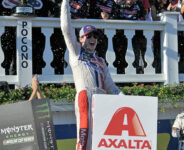Of all the arguments made in favor of the XFINITY Series being a members-only division or at least diminishing the participation of Cup drivers, this stretch of Dash 4 Cash events (Bristol, Richmond, Talladega, Dover) has shown some of the best racing of the 2018 XFINITY season, all of which have been run by series regulars.
Diehard fans and racers who have felt that NASCAR was letting the series waste away through Cup participation have been vindicated considering the racing product has been excellent during this all-too-brief stretch.
Granted, Cup participation in 2018 is supposed to have diminished among drivers, and for the most part, it has. But this season, in the first six events prior to the Dash 4 Cash, only one regular has won – Tyler Reddick at Daytona. Since then, Kevin Harvick, Kyle Larson, Brad Keselowski, Joey Logano, and Ryan Blaney have all dominated the 2018 season.
This was a trend that was bucked seven races in when Ryan Preece scored his second career win for Joe Gibbs Racing. That was followed by Christopher Bell scoring his second career win at Richmond, then Spencer Gallagher scored his first-career win at Talladega. Although Preece is running a limited XFINITY campaign he’s still counted for XFINITY points. Otherwise, out of nine events in 2018 three full-time series regulars have won.
It’s been said before and it will be said again, this isn’t good for business. What is good, though, is seeing the XFINITY Series provide new faces and new, fresh winners, which is exactly what’s going on.
Granted, that’s bound to change. In the continuing quest for the “Owner’s Championship,” a paper championship with no real prestige, Cup drivers will be in future events this season in Cup-backed rides. There are still stand-alone events to look forward to at Iowa, Mid-Ohio, and Road America before the playoffs begin on September 21 at Richmond, where Cup regulars will be absent from competition for the rest of the season.
The Dash 4 Cash events have helped bring the true stars such as guys like Reddick, Preece, Bell, and Gallagher to light, and Dover could only add to that list. The XFINITY Series has had to deal with an identity problem where opportunities were stolen from up-and-coming drivers who saw their opportunities come and go due to Cup interference. To see more emphasis placed on their role in the sport – they’re NASCAR drivers too, just so that’s clear – is great for the sport, but it shouldn’t be as limited as this.
IndyCar doesn’t have this sort of identity issue with Indy Lights. Formula One doesn’t have an issue with this in their feeder series. NHRA doesn’t. IMSA doesn’t. Why does NASCAR? Why should they? That’s not to say that Nascar should ban Cup drivers and affiliations. Instead, continue to diminish their competition roles, and focus on the growth of a division that was originally created to be more than a feeder division. NASCAR is more than just the Monster Energy NASCAR Cup Series, so let’s treat it as such.










